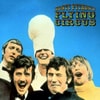

On the surface, Graham Chapman seemed the sanest of Britain's Monty Python troupe - he was tall, well-spoken and apparently possessed of refined manners. That veneer soon fell away within minutes of the launch of a sketch, whereupon Chapman would erupt into arias of mad behavior that skewered not only his own appearance, but the staid gentility of England's upper class. He found that streak of inspired insanity while a student at Cambridge, and with fellow alum John Cleese, began contributing to UK television and radio comedies. In 1969, he and Cleese teamed with Eric Idle, Michael Palin, Terry Gilliam and Terry Jones to form Monty Python, an unbridled comedy troupe whose stream of consciousness approach would have a lasting impact on world humor for decades to come. Chapman remained with Python until his untimely death in 1989, which robbed audiences of one of the most irreverent minds in entertainment.

Rankings
SEE ALL RANKINGS
#91
OF 97
#164
OF 218
Help Topic: What do these scores mean?
People
Music
Films
why?


Musical comedy | 1975 | Budget $1.2M | Box Office $112M
Tim Curry, Susan Sarandon, Barry Bostwick
why?


Science fiction | 1968 | Budget $12M | Box Office $71M
Keir Dullea, Gary Lockwood, William Sylvester
TV
why?


BBC1 | Comedy | 1969 - 1974 | Ended | 4 Seasons | 47 Episodes
John Cleese, Terry Jones, Graham Chapman
why?


BBC2 | Sitcom | 1975 - 1979 | Ended | 2 Seasons | 12 Episodes
John Cleese, Prunella Scales, Connie Booth
why?


BBC One | Comedy | 1983 - 1989 | Ended | 4 Seasons | 24 Episodes
Rowan Atkinson, Brian Blessed, Elspet Gray
why?


COMEDY | Animated | 1997 - 2025 | Returning Series | 27 Seasons | 582 Episodes
Trey Parker, Matt Stone
why?


CBC | Comedy | 1989 - 2021 | Ended | 5 Seasons | 124 Episodes
Dave Foley, Bruce McCulloch, Kevin McDonald
why?


DAVE | Sitcom | 1988 - 2022 | Ended | 12 Seasons | 77 Episodes
Craig Charles, Danny John-Jules, Chris Barrie
why?


PARSHO | Horror | 2014 - 2016 | Canceled | 3 Seasons | 28 Episodes
Timothy Dalton, Eva Green, Josh Hartnett
why?


BBC1 | Sitcom | 1972 - 1985 | Ended | 10 Seasons | 69 Episodes
Trevor Bannister, John Inman, Wendy Richard
why?


NETOV | Sitcom | 2003 - 2019 | Ended | 5 Seasons | 87 Episodes
Jason Bateman, Portia de Rossi, Will Arnett
why?


BBC1 | Science fiction | 2005 - 2021 | Ended | 13 Seasons | 160 Episodes
Jodie Whittaker, Mandip Gill, John Bishop
Sports
Fictional Characters
Brands & Products
Audience Affinity
Movies
73
Comedy
71
Comedy Movies
26
Rock Music
25


















































































